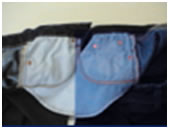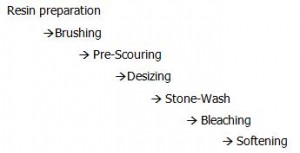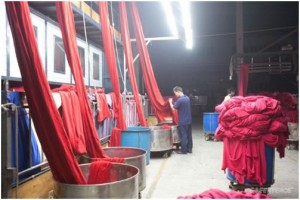Jeans bleaching – advantages and risks of different bleaching processes (1/3)
The dyeing and finishing of ready-made jeans garments has gained increasing prominence in recent years. The global market for denim jeans is projected to reach $56 billion by the year 2018, according to Global Industry Analysts.
 Originally used exclusively for workwear, jeans have gained a position of ever-increasing importance in the clothing market, due to wearing comfort and fashion. Designers learned to make jeans attractive to an ever increasing number of customers through innovative modifications and styling. One of the increasing styles – especially for the summer season – is bleached jeans. “Bleached jeanswear is back in vogue and is most suitable for a lovely and romantic look.” [1]
Originally used exclusively for workwear, jeans have gained a position of ever-increasing importance in the clothing market, due to wearing comfort and fashion. Designers learned to make jeans attractive to an ever increasing number of customers through innovative modifications and styling. One of the increasing styles – especially for the summer season – is bleached jeans. “Bleached jeanswear is back in vogue and is most suitable for a lovely and romantic look.” [1]
Bleached denim, of the garment washed, are stone-washed and bleached with different chemicals and treatments. Bleaching is a treatment of textiles in order to lighten the fabric for the final shades.
 Moreover, the backstaining on the pocket linen and the weft yarn should be removed to increase the contrast. There are various processes used to obtain lightened denim fabrics. These effects can be made with a chemical treatment, with biotechnological or mechanical treatments. This blog article will give a general overview of the different possibilities, their impact to the environment and implications for the Zero Discharge Hazardous Chemicals project (ZDHC), a project which was initiated by retailers and brands as a response to the Greenpeace detox campaign.
Moreover, the backstaining on the pocket linen and the weft yarn should be removed to increase the contrast. There are various processes used to obtain lightened denim fabrics. These effects can be made with a chemical treatment, with biotechnological or mechanical treatments. This blog article will give a general overview of the different possibilities, their impact to the environment and implications for the Zero Discharge Hazardous Chemicals project (ZDHC), a project which was initiated by retailers and brands as a response to the Greenpeace detox campaign.
The wet garment process is made mostly by the following sequence:
Pale jeans with only a low concentration of indigo are particularly sensitive against environmental influences. Yellowing and fading of fabrics dyed with indigo, during storage, is a problem in the denim industry. It may be caused by exposure to light or aggressive chemicals such as nitrogen oxides, ozone or chlorine. This results in yellowish decomposition products originating from indigo, that can be washed out, leaving lighter coloured areas.
Some jeans have a bottoming with sulphur dyes, especially with C.I. Sulphur Black 1. This is the most important dyestuff for black denim and also used for topping or bottoming of dark indigo blue dyeings. But not all bleaching chemicals have the same effect in bleaching sulphur dyes. If the bleaching process only affects the indigo dye, black or grey shades will received. In other cases a grey cast is on the faded Indigo, which sometimes is wanted for special styles.
There are general product requirements and special requirements for bleaching agents, which are used for the finishing of ready-made garments:
- cost effective
- easy handling
- simple process, making use of existing machinery
- ecological concerns
- global availability (of the chemicals )
- no or only low fiber damage
Special requirements of the bleaching agent:
- flexible degree of bleaching
- bleaching activity moderated opposite different dyestuff classes
- good reproducibility of the bleaching effect
- short processing time
- no extensive aftertreatment
- suitable for all fiber and fiber mixes (e.g. elasthan)
- no backstaining and good contrast
- resistance to yellowing
Outlook
The following articles of this series will provide a general overview of the different possibilities to bleach various jeans products, depending on various textile articles and available machinery, each with their specific requirements.
References:
[1] trendblogger.com/jeans-trends-and-styles-spring-summer-2012-2013




